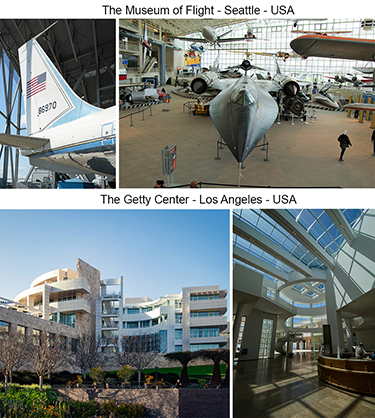
Museums are buildings and grounds that collect and share artifacts, artwork, objects, and historical human innovations spanning centuries and civilizations. Museums are more than just buildings that hold collections. They are spaces where people connect with history, culture, science, and art. The design of a museum plays a significant role in shaping how visitors experience these collections and how the institution fulfills its purpose. Today, there are more than 95,000 museums worldwide, demonstrating the significant role these spaces play in preserving knowledge and shaping communities. Museums are also engaging and social places, especially in modern times, where people gather not only to learn but also to share experiences with friends, family, and communities. Museums are not just buildings containing exhibits; they are also world heritage sites that people can visit, and archeological sites that we can learn from. The International Council of Museums has 57,208 members in 137 countries and territories, as of 2023. Museums are open books exploring the creative world.
Activity 1 – What is a Museum For?
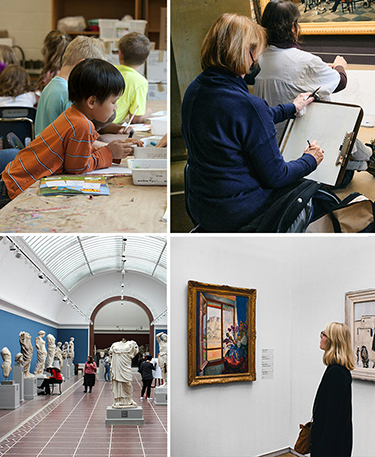
A museum is a place where objects of historical, cultural, scientific, or artistic value are collected, preserved, and displayed. According to the International Council of Museums (ICOM), a museum must serve society, be open to the public, and provide both educational and enjoyable experiences. In 2019 alone, museums in the United States attracted over 850 million visitors, surpassing the combined attendance of all major league sporting events. This illustrates the central role museums play in public life. Modern museums are no longer silent halls but lively social places, where people attend talks, participate in workshops, and even enjoy concerts. Museums often feature education centers, exhibit halls, docents who lead tours of the various aspects of the collections, and curators, who are responsible for organizing the exhibits.
What is the first museum you ever visited, and what impression did it leave on you?
Activity 2 – Evolution of Museums
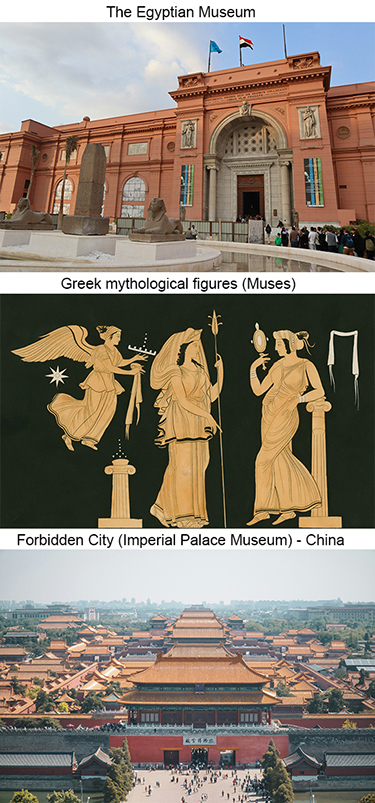
Museums have existed for thousands of years. One of the oldest known museums was founded around 530 BCE by Princess Ennigaldi-Nanna in ancient Mesopotamia. The Egyptian Museum in Cairo houses over 120,000 items, with a representative amount on display. Located in Tahrir Square in a building built in 1901, it is the largest museum in Africa. The Forbidden City, also known as the Imperial Palace Museum, located in Beijing, served as the residence of emperors for nearly five centuries. Popularly known as the Forbidden City, it was built during the Ming Dynasty between the 4th and 18th years of the Yongle period (1406-1420 AD). Now a World Heritage Site, it boasts the most extensive collection of preserved ancient wooden structures in the world. The architectural complex spans over 2,350,000 square feet, comprising 9,999 rooms. The largest complex of its kind in the world, the museum is surrounded by ten-foot-high walls that are crowned by observation towers and flanked by a deep moat. The walls are pierced by four large gates, each with three openings and a broad crowning pavilion. The word “museum” comes from the Greek “museion,” meaning a place dedicated to the Muses (the nine Greek goddesses of arts and learning). By the 18th century, public museums, such as the British Museum, had opened their doors to the public. Today, many museums focus on inclusivity, digital access, and interactivity, helping attract new audiences. During the COVID-19 pandemic, more than 90% of museums worldwide temporarily closed, but many utilized online tours and social media to remain engaging and social spaces despite physical closures.
Do you think museums today should focus more on preserving the past or on inspiring the future?
Activity 3 – Types of Museums
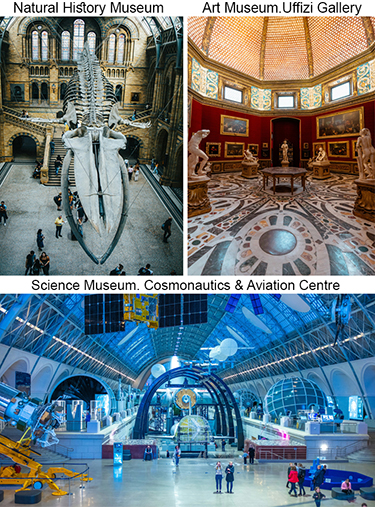
Not all museums are the same. Some Art museums display paintings, sculptures, and installations; natural history museums show fossils and species; science museums focus on innovations, technology, and discovery. There are also highly specialized ones, such as the Museum of Evolution in Paris, the Indigenous Peoples’ Museum in Washington, DC, the SPAM Museum in Minnesota, USA, the Pompideau Art Museum, and the many Children’s Museums around the world designed to spark curiosity through play. This variety makes museums appealing to people of all ages and interests, offering engaging cultural gathering spaces.
If you could design a new museum, what type would it be?
Activity 4 – Locating Museums
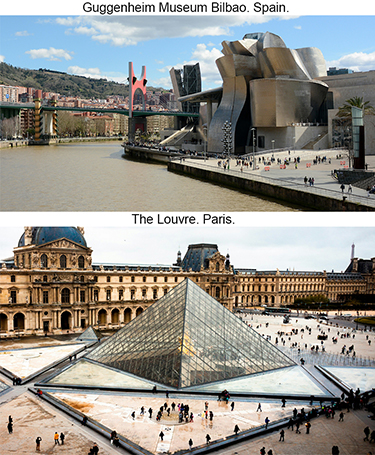
The location of a museum has a direct impact on its success. The Guggenheim Museum Bilbaois an excellent example: since its opening in 1997, it has attracted over 20 million visitors and contributed billions of euros to the local economy. Location can turn a museum into a symbol of a city. Accessibility, proximity to transportation, and integration with the urban environment are critical factors. A museum placed in a lively cultural district naturally becomes a social gathering hub, blending with cafés, theaters, and parks. Another Gehry-designed museum, the Vuitton Foundation Museum, on the edge of Paris, offers special exhibits and fabulous views of the hinterlands. The Getty Museum, by Richard Meier, architect, is a series of buildings and gardens on a hilltop in Los Angeles.
If you could place a new museum in your city, where would you put it and what would it offer?
Activity 5 – Spaces inside Museums

Inside a museum, the layout balances beauty, access to exhibits, archival storage, business offices, and circulation. Lighting and scale of each of these different functions dictate entry and exits through the museum.
The large open vault of the Milwaukee Art Museum, designed by the architect Santiago Calatrava, offers an expansive, sky-filled, welcoming space for weddings, receptions, presentations, cafe setups, and special events, overlooking Lake Michigan.
Some museums offer access to rooftops, like the NEMO Science Museum in Copenhagen, and Underground access to caves. Exhibition halls, storage areas, auditoriums, and visitor amenities must all work together.
The Musée d'Orsay is a museum in a former train station. Its vaulted interior space allows for three floors of exhibits on each side as well as a viewing deck to see the city over the Seine and back to the Louvre.
The Louvre in Paris, for example, has over 652,000 square feet of gallery space, making it the largest art museum in the world. Good lighting, clear pathways, and flexible halls are essential. It’s the De Soto Desud gallery with large paintings from floor to ceiling, offering an incredible view of past lives in action.
Many new museums also feature cafés, lounges, and interactive spaces where people can meet and exchange ideas. This highlights the museum as a space for both learning and social interaction.
What makes you feel most comfortable when visiting a museum, spacious halls, quiet corners, or interactive displays?
Activity 6 – DESIGNING FOR VISITORS
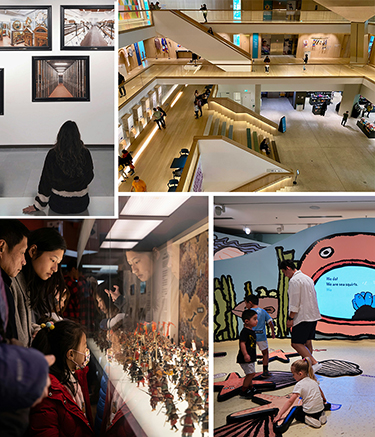
Museums are for people, not just for objects. Accessibility is now a top priority: ramps, elevators, and inclusive signage help ensure that all visitors can enjoy the experience. The Smithsonian Institution reports that more than 30% of its visitors are families with children, so spaces for learning and play are built in. A visitor-centered design encourages people to socialize, whether through guided tours, group workshops, or open courtyards where conversations happen naturally. These small details make visitors feel welcome and encourage them to return. Some museums open large, welcoming spaces with skylights and sunshine. Others share outdoor garden courtyards.
What small feature, like benches, maps, or friendly staff, makes your museum visit more enjoyable?
Activity 7 – World Famous Museums
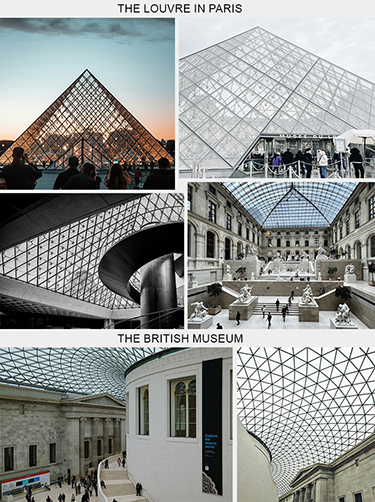
Many museums are cultural giants with long histories. The Louvre in Paris, formerly a royal palace, was converted into a public museum in 1793 during the French Revolution. Today, it holds around 35,000 works of art on display, including Leonardo da Vinci’s Mona Lisa and the ancient Greek statue Venus de Milo. Visitors enter through the famous glass pyramid, which blends historic architecture with modern design. The British Museum in London, founded in 1753, houses treasures from across the world. Highlights include the Rosetta Stone, which helped scholars decode Egyptian hieroglyphs, and the Parthenon sculptures from Athens. Its latest renovation included a Natural Light Glass-covered skylight offering a cafe and sitting areas with access to protected galleries.
If you had the chance, which of these iconic museums would you visit first, the Louvre or the British Museum?
Activity 8 – Modern Museums
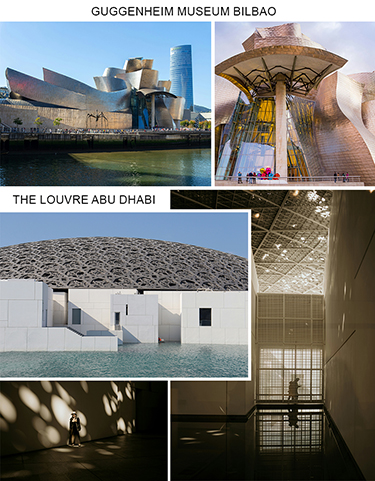
Modern museums make bold statements through architecture. The Guggenheim Museum Bilbao in Spain, designed by Frank Gehry, opened in 1997 and is known for its curving titanium walls that shimmer in the light. Inside, vast open galleries host contemporary art exhibitions. The building itself has become a global symbol of modern design. The Louvre Abu Dhabi, opened in 2017 in the United Arab Emirates, is equally striking. Its massive floating dome, with 7,850 perforated metal stars, filters sunlight to create a “rain of light” effect inspired by palm trees. The museum’s collection includes works loaned from French institutions, blending Eastern and Western art in a space that celebrates cultural exchange. The Museum des Confluences shares life forms from all over the globe with historic elements created by people.
Do you think the building of a museum can be as important as the objects it holds?
Activity 9 – World Famous Museums in the United States
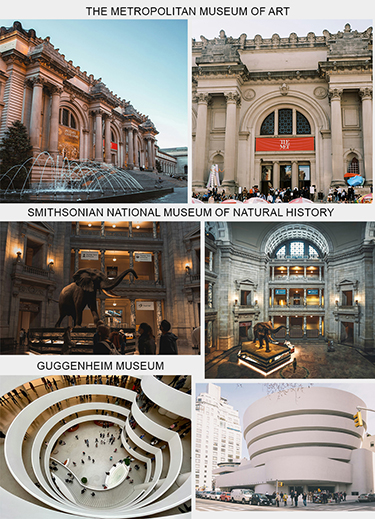
The United States is home to some of the world’s largest and most diverse museums. The Metropolitan Museum of Art in New York, commonly referred to as “The Met,” houses over two million works, spanning from Egyptian mummies to modern paintings. Its steps on Fifth Avenue are a popular meeting place, while inside, highlights include the Temple of Dendur and works by Van Gogh and Rembrandt. In Washington, D.C., the Smithsonian National Museum of Natural History is part of the Smithsonian Institution, the world’s largest museum complex. It consists of 21 museums and a national zoo! It welcomes about seven million visitors annually, who come to see its 145 million specimens and artifacts, including dinosaur skeletons, giant gemstones, and detailed cultural displays. Other famous museums include the Guggenheim in New York, the Museum of Modern Art, the National Building Museum, and the East Building of the National Museum of Modern Art (by I.M. Pei) in Washington, DC.
If you could spend a whole day at The Met, or MOMA, or the Smithsonian, which would you choose and why?
Review
- In 2019, museums in the U.S. attracted more visitors than all major league sporting events combined.
- The Forbidden City Museum in Bejing has exactly 5,500 rooms
- The Guggenheim Museum Bilbao, opened in 1997, has attracted millions of visitors and boosted the local economy.
- The Louvre in Paris has the largest gallery space of any major museum in the world.
- More than 30% of Smithsonian visitors are families with children.
- The Mona Lisa and Venus de Milo are displayed in the Louvre Museum in Paris.
- The Louvre Abu Dhabi’s dome is solid and blocks all natural sunlight.
- The Metropolitan Museum of Art (The Met) in New York has a collection of over two million works.
Explore
- British Museum, London
- Eastern Shoshone Cultural Hub Museum
- Edo Tokyo Museum Japan
- Grand Galleriy of Evolution, Jardins Des Plantes, Paris
- Grands Galleries Des Evolutions Jardins des Plantes, Paris
- Guggenheim Bilboa
- HGA 6 Trends Shaping Museum Design
- Indianapolis Children Museum
- Knutenborg Museum of Natural History
- Metropolitan Museum of Art, New York City
- MS/ Maritime Museum of Denmark
- National Children's Museum South Korea
- National History Museum, London
- Nemo Science Museum Rooftop
- Oldest Museums in the world
- Shanghei Musem of Natural History
- Smithsonian Natural History Museum Washington, DC
- St. Louis Magic House for kids
- The Acropolis Museum
- The Acropolis Museum Management
- The Alexandria Museum of Cairo
- The Louvre, Paris France
- The National History Museum London


















































